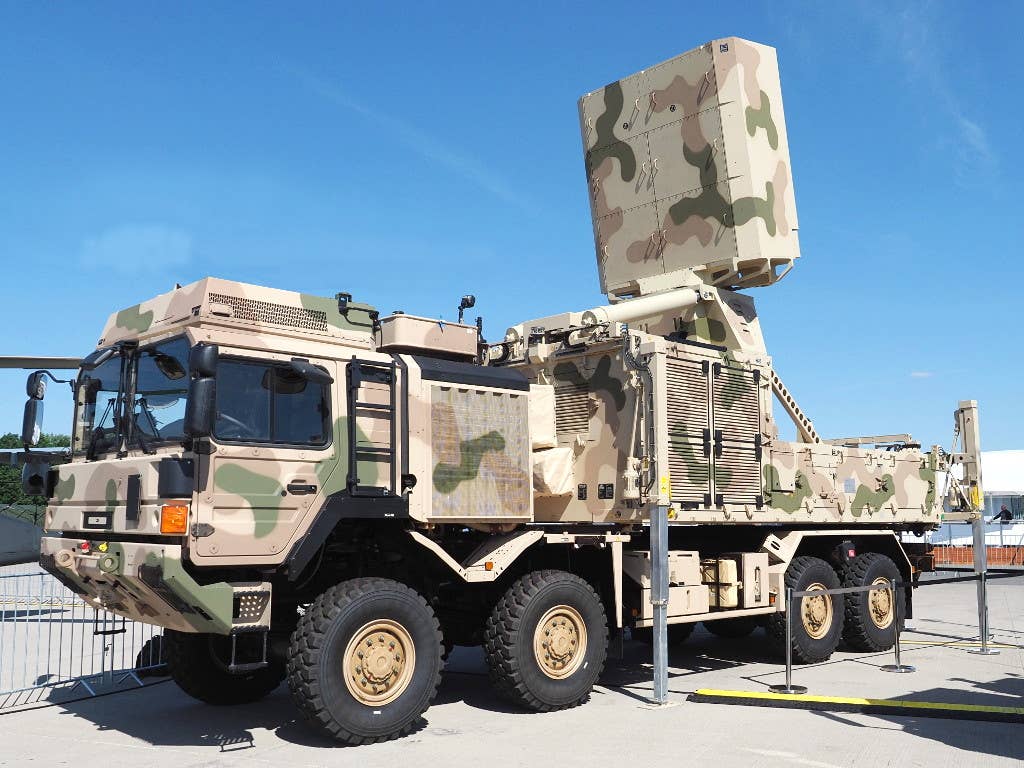In a video that has recently surfaced on social media, a Russian ‘Lancet’ loitering munition could be seen delivering a massive blow to the Hensoldt TRML-4D truck-mounted radar, which is a crucial component of the German IRIS-T air defense system.
Russian EW ‘Ambushes’ Mohajer-6 Drone Over Crimea; Officials Celebrate, Mourn The Downing Of Iranian UAV
This radar, an essential part of the IRIS-T SLM surface-to-air missile system, might be the only one Ukraine has received so far. A launcher connected to this system is shown in other photos, implying that it was also hit in the drone attack.
A typical single IRIS-T SLM system consists of three mobile launchers, a truck-mounted multi-function radar, and another truck modified into a command post vehicle.
The truck-mounted missile system is intended to take down combat aircraft, attack helicopters, drones, anti-radar missiles, cruise missiles, bombs, and drones. The multipurpose radar, for one, is tasked with tracking multiple targets at once.
On June 7, social media was flooded with the video and claims by Russian microbloggers that a Lancet drone strike hit a Patriot launcher. However, with the subsequent release of the video, it was later recognized as a TRML-4D radar used by the IRIS-T air defense system.
The video is published. Not a Patriot launcher (as initially claimed by some Russian channels) but a TRML-4D radar, used by the IRIS-T air defense system was possibly taken out by a Lancet kamikaze drone. The impact isn't captured, so it's hard to determine what damage is done. https://t.co/8BKyLNNmKt pic.twitter.com/2QGJkgMPZ4
— NOELREPORTS ?? ?? (@NOELreports) June 7, 2023
Since the range of a Lancet loitering munition is known to be somewhere between 40 and 70 kilometers, the TRML-4D radar was presumably positioned along the frontlines.
In the video, a person can be seen standing atop the radar truck’s cab just before the kamikaze drone appears to hit it. The TRML-4D remains motionless while other adjacent workers and another truck can be seen scurrying away in the last shots of the video.
As soon as the video surfaced on the internet, it went viral on social media. Since the footage, which is over 35 seconds long, does not capture the strike’s impact, military watches could not accurately assess the damage caused by the strike.
Some military watchers believe cues suggest the radar array may have been impacted. However, it could result from other viewpoint changes or a simple lighting illusion. The exact extent of the impact hasn’t been officially revealed by the Ukrainian Armed Forces that operate the system.
"Iris" cut – German air defense system IRIS-T SLM hit by Russian "Lancet"
It is not known why the enemy decided to place this anti-aircraft missile system so close to the front line. It may have been planned to set up an air defense ambush, similar to the one that happened in… pic.twitter.com/e8doaHEzTX
— Zlatti71 (@djuric_zlatko) June 7, 2023
Only still pictures of the alleged attack on the IRIS-T SLM launcher are available, and they appear to have been taken before the loitering munition struck. However, radars are notoriously delicate, and even if they are repairable, a small bit of damage could result in a mission kill and render the device inoperable for a while.
The TRML-4D is a cutting-edge road-mobile active electronically scanned array C-band air surveillance radar. When used as a component of a surface-to-air missile system like IRIS-T, it also includes high-fidelity tracking functionality that eliminates the need for a separate fire control radar.
This could be a significant loss for Ukraine since it reportedly has just one TRML-4D, although Germany has pledged at least seven more in its recent package. Currently, Ukraine has two fully operable IRIS-T air defense systems in its inventory.

So, until Germany finally delivers the radars as promised, the operations of the IRIS-T air defense system could be impacted. This is significant given that intense fighting is raging on the frontlines, with Russian troops launching a barrage of missiles and UAVs at Ukraine.
Not just that, the Russians have been allegedly making meticulous efforts to annihilate Ukraine’s missile defenses and anti-aircraft system launchers to render it defenseless. This was recently noted with Russian missile strikes to destroy the Patriot missile battery operating near or inside Kyiv.
The IRIS-T was the first Western air defense system delivered to Kyiv from Germany after a massive Russian missile strike that began in October. The system is known for its impeccable performance and a successful combat record that Ukrainian operators and high-ranking officials have often praised.
IRIS-T’s Combat Record Against Russian Attacks
Germany delivered the first IRIS-T air defense system to Ukraine in October after a massive Russian missile strike on Ukrainian cities. The first evidence of its deployment was recorded just days after its delivery, with visual evidence doing rounds on social media.
The second IRIS-T was delivered in mid-April. Days after this delivery, Lieutenant General Mykola Oleshchuk, head of the Ukrainian Air Force, said in a Telegram post on May 3 that a division of the IRIS-T air defense systems had destroyed more than 60 hostile aerial targets over Ukraine since October 2022.

Later, he also released a video of the systems in use. On multiple occasions, Ukrainian commanders and military analysts have stated that the IRIS-T is a great asset because it can share data from its radar with “neighboring” air defense systems. This enables smooth air defense tracking to neutralize adversary targets.
“Everyone had a great impression on the first day of using the system,” said another Ukrainian military officer, nicknamed ‘Jeweler’ and is the deputy commander of an anti-aircraft missile unit. “First of all, because they shot all (targets) down.”
It has been praised by Ukrainian operators ever since it was first deployed in combat. In January, the Ukrainian military said that the IRIS-T successfully downed every incoming target during Ukraine’s first operational use of the system, as reported by EurAsian Times.
The former German defense minister announced that Kyiv would get at least three air defense systems in 2023.
IRIS-T manufacturer Deihl claimed that coupling it with the US-made Patriot PAC-3 missile defense system with a higher maximum altitude will maximize its effectiveness.
- Contact the author at sakshi.tiwari9555 (at) gmail.com
- Follow EurAsian Times on Google News





